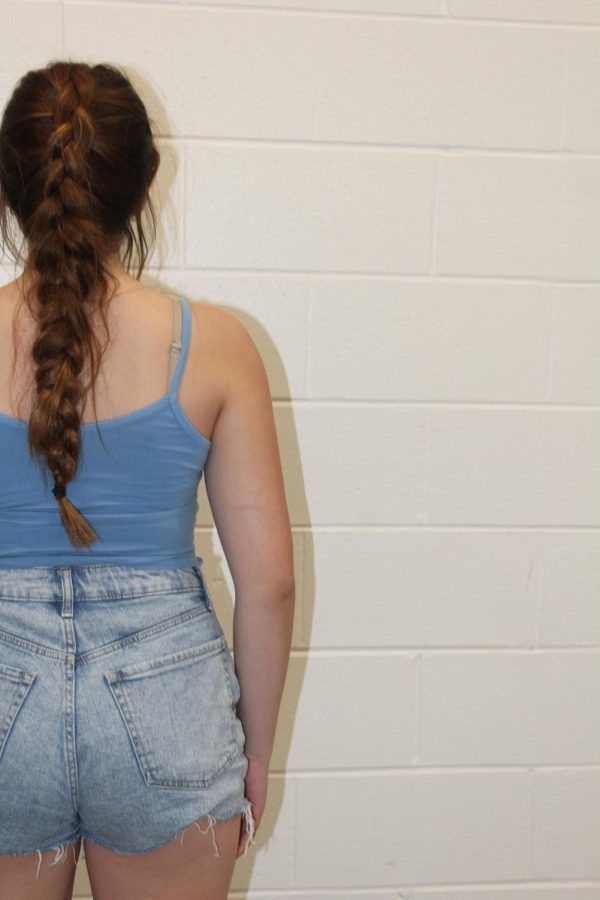Dress to Impress
Students, staff share impacts of new dress code
Photo by Sashrika Shyam. consent given by Kyra Keena
The new dress code has made drastic changes, such as undergarments must be covered and shorts must fall 3 inches below the undergarment line.
On August 2nd, the superintendent sent out a newsletter with an important update regarding the schools dress code. This new dress code resulted in many controversial opinions due to the extreme change.
A quick change
The new dress code has led to questions arising regarding the mental health impact of getting dress coded. Jane, whose name has been changed to protect her identity, has a viewpoint and opinion that has been shaped from this perspective.
“The day I got dress-coded, I was very upset. I tried to not let it impact my studies because I didn’t want to waste my energy on it, but I was very distracted in class,” Jane said.
In addition to the dress code impacting her focus, Jane also said that she found it hard to find clothes that were abiding by the dress code.
“I always love planning outfits, it’s just something I look forward to. […] Now it’s impossible to find any store who follows popular fashion trends that sell clothes that are not deemed inappropriate by the school.”
Jane also believes that the new code caused a “large impact” due to the late notice from the district.
“A lot of my friends and I ordered our clothes for school [before the dress code change]. It is not like every single family can go out and afford to buy new clothes that fit the new code,” she said. “It’s very hard to find cute clothes that fit the dress code at the last minute.”
In addition to the unavailability of clothes, Jane also found that the change was “too sudden.”
“It feels strange, because I am a senior now and I’ve never experienced this before,” Jane said. “I didn’t have enough time to prepare myself, mentally, for the large shift.”
While Jane is unhappy with the results of the dress code, she does not blame those whose job it is to enforcer the rules.
“I know that it’s [the dean’s] job, I don’t blame them at all. I think it’s a little bit unnecessary. I didn’t see any problems with the dress code last year, but it is frustrating to see it happening everywhere now,” Jane said. “For me, it’s distracting from the main point of school: to learn.”
Suited up for the future
Teachers such as Sheri Conover, band director, find that there are more benefits to the dress code.
“I personally do [see benefits in the new dress code]. I’m kind of old school where I think that how you present yourself, you know, in your clothing choices makes a big difference in how you work in school, how you interact with people, their perception of you,” Conover said. “Again, it’s kind of old school.”
There are many reasons for the change, Conover says, such as appropriately dressing for temperatures and for the future.
“I think that part of it is dressing appropriately for temperatures, for example, in the school, making sure that you have layers that if there are various temperatures in the building. Other than that, having the appropriate clothing choices, such as being covered up [is necessary]. You do not go into a job interview with an abdomen showing, you do not go with jeans that are torn and too short shorts,” Conover said.
While she sees the future benefits in the dress code, Conover says she does not see that large of an impact in band rehearsals.
“I think that because I’m working with band students and we’re outside, I don’t see an impact right now. So generally because it’s been hot, they’ve not had to be excessively dressed or don’t worry too much about what they were wearing,” Conover said. “But I would say that in general, it doesn’t really affect how we act in our class. So the only caveat to that would be I would prefer that students not wear hats and things because we want to be able to see them and interact with them.”
Because teachers lost so much interaction time with students on zoom, Conover says that how a student dresses impacts that connection.
“I think that a large part of my longer term experience is that you can have a concept, or a preconceived notion about how people are dressing and how you can approach them or not approach them and I find that it is a difficult and a challenging line to balance,” Conover said.
Conover believes that the reason for the sudden change was due to the more relaxed rules last year due to the impacts of the pandemic.
“I think that last year, there were a lot more allowances for hoods and hats and just everybody had the option to dress as comfortably as they wanted to. But that’s from being home the previous year,” Conover said. “And I think that because this year, there’s a little more crackdown on what everybody can and cannot wear. There is most likely a push-back, but it should bring us back to where we should be.”
Conover thinks that the place that the school are at with the dress code now “teaches students how they are expected to dress in the future.”
“There are social norms, there are codes that [students] will ultimately have to follow. You know, not every workplace allows everybody to dress down. Not every workplace allows you to work remotely,” Conover said. “In many places you have to wear a uniform, in many places you have to present yourself to customers. And their perceptions of your company and you as a worker are reflective of what you’re wearing. I think that still holds true for lots and lots of people that are in the business world.”
A neutral tone
Students such as Anne, whose name has been changed to protect her identity, feel as though the dress code is not a drastic change from the old one. In her opinion, it does not affect her directly.
“If your favorite shirt doesn’t follow the dress code, you can’t wear that shirt. But you can just wear that shirt on Saturday. […] I just do not find it such a big deal when I pick my clothes each day, I don’t see them as crazy rules and I want to follow the rules they put in place.”
While she believes that the rules aren’t severe, Anne also believes that people should not be dress coded for minor infractions.
“Honestly, there’s so many people that are just not really following [the dress code]. I just don’t know if it’s fair in the minor cases, but at the same time just follow the rule,” Anne said. “[O]obviously if your shorts ride up because you’re reaching for something or doing something active, then it shouldn’t be a big deal.”
However, Anne feels that people tend to “make [the new dress code] a bigger problem than it is.”
“We will be in school only eight hours a day, five days a week. There are two other days [of the week] where you can wear whatever you want, even at night on school days,” Anne said. “There are [going to be] other opportunities for us to wear other clothes that are not school appropriate.”
The dress code duality
“I think that if a girl wears a tank top and she gets dress coded, a boy should get dress coded for wearing a muscle tank. It should be fair,” Anne said.
“I think that if the district decides to dress code girls for tank tops and short shorts, boys should be dress coded if they’re wearing similar things. It shouldn’t be different between genders,” Jane said.
“These social norms go for both boys and girls, there is a certain standard dress code in the business world for both genders, not just one or the other,” Conover said.

During her third and final year on the Bear Facts staff, Sashrika is looking forward to assuming her role as LZ Life Editor and Social Media Manager. When...

